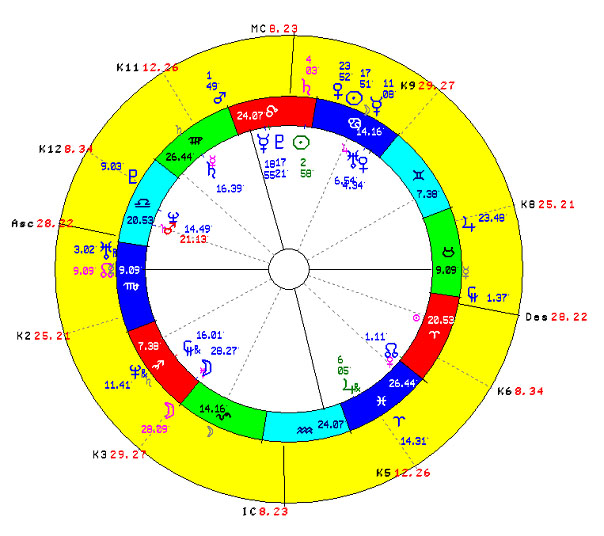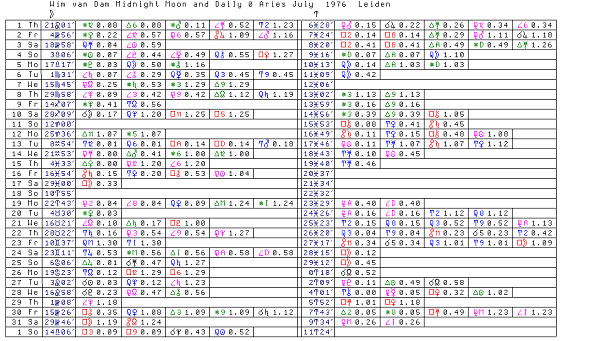
|
THE DAILY HOROSCOPE AND THE MIDNIGHT MOON Copyright © 2007 All Rights Reserved by Wim van Dam Many astrologers use some system of a daily horoscope. In this paper I want to demonstrate one that I partly developed, and partly derived from Sepharial (p. 226 ). Sepharial then advises to cast a horoscope for the actual day, with place and GMT of birth. Technically speaking, this means one progresses the radical MC by the Naibod measure of 0 59'08" a year in right ascension. Most astrologers like me, are reluctant to this since it is quite usual to progress the radical MC at the speed of the secondary sun in longitude for each year of life. One would expect the same to hold good for the daily horoscope. In practice, Raphaels method proves to be the best one to use, if only one limits the number of possible contacts. If one accepts all possible aspects from the daily transiting cusps to the radical and transit planets one will always find applicable results - and many more non-applicable ones. If one uses only conjunctions between daily cusps and transiting or radical planets, the result will be clear. A problem with the above method is: what time should the moon be calculated for? Will you use the GMT of birth? Some astrologers do so, but I never found this much informative. The solution comes from an observation I once casually made:
The above finding proved to be no coincidence: the moon's position at local midnight gives most valuable information. Now of course, I was lucky to use GMT 0-hours ephemeris, since 0 hours at Greenwich almost coincides with 0 hours in the whole of the Netherlands. It is not difficult to program this for any place in the world as a kind of calendar for a month. All aspects to the radix are sorted by orb, with the benevolent aspects colored green, the malevolent aspects red and the other ones blue or black (see the end of this article). As an example of the technique, below is my own horoscope, with the daily cusps on the outside circle, planets and the midnight moon for the day of my M.A. (slavonian linguistics), 9th of July 1976. This chart was produced from Morinus 2000:  Shown above, Transiting Saturn (ruler of my third house and most applicable for the archaic Slavonian languages with their extensive declination- and flexion system), natural ruler of ten and radically positioned in ten conjunct to the radical sun, actual ruler of ten (all of which is most applicable). We see that both the daily axis 3 - 9 (languages, matters abroad) and the midnight moon are conjunct to the radical moon, ruler of nine. This of course is a very mighty combination, probably made even stronger by the sextile from the daily ascendant. I don't like using other aspects than the conjunction in daily horoscopes. One might also use the midpoint between transiting Mercury (languages) and the transiting sun (ruler of ten, radically in nine), which midpoint happens to fall exactly at the radical ninth cusp. Important: the influence of the midnight moon is sensible until about the moment the sun passes the upper meridian (the MC), from which moment, the moon's position of next midnight starts ruling. So its influence extends from midday the day before until midday next day. The ultimate boarder is not defined by the sun being on the MC but probably somewhere in the ninth house. This theory should be researched on a lager scale however. Like everywhere in astrology, there probably will prove to be no sharp clear-cut boarder that covers all cases. The midnight moon for my M.A., later in the afternoon, as given above therefore was not calculated for the 9th of July 0 hours but for July 10th. Possible misunderstanding: The above details can rise to serious misunderstandings. When I was to get married in 1986, my then fiancée, now my wife, called from Warszaw to ask me what Saturday in June would be most fitting. I consulted my ephemeris and a quick glance showed me that the 14th of June was the best date. The midnight moon was sextile to my radical Venus. Only later I found out that the wedding was to take place at 3:00 pm, which made the midnight moon of Sunday morning applicable. This moon was not only in a quintile to my Venus but also in conjunction to my Saturn and we have certainly noticed both influences. Have we covered all parts of the daily horoscope such as cusps, Sun, Moon and planets? Not quite. After so many trials and errors, I found another daily indication. In order to understand this, we now have to digress on primary directions (p.d.). In p.d.'s, all planetary points, cusps and planets, are progressed at about one degree a year whith each one having different speed (just like the ascendant moves by a half up two and a half degrees a year). In fact, with the use of p.d.'s, one can progress each point in the horoscope, even if it is empty. I soon found out that one can progress the point 0 Aries too, its aspects most often indicating a change or the start of something new in life. I started publishing on astrology when my primary 0 Aries was trine to radical Mercury (conjunct to Pluto) in nine. I started working in a real fixed job when it came in a trine to my MC. I would like to stress here that contrary to my expectations progressing the point 0 Cancer did not give any significant results. I was curious to see whether daily primary directions of the solar horoscope might give any interesting indications. What I mean is this: calculate the solar return, progress its MC at the Naibod measure in right ascension for each day, and calculate the corresponding primary directions and check their aspects to the radix (not to the solar return itself!). For some reason or another, the cusps and planets did not give much valuable information, but the aspects from 'daily' 0 Aries to the radix clearly did. For the day of my marriage, my daily 0 Aries had a position of 2 Aquarius, meaning its opposition point (analogous to 0 Libra and the descendant of course) was conjunct to my radical sun in nine. For the day I became a father, the midnight moon was at 3 Taurus - conjunct to that year's primary cusp 5 and in a square to the radical sun in Leo (5, sun and Leo all being related to children). A square to sun in Leo is of course a good aspect, the more so since radical cusp 5 is in a trine to the sun. Daily 0 Aries was in a tredecile to my moon - at first sight not so applicable, but 3 Taurus, primary cusp 5, happens to be the moon's degree of exaltation so cusp 5 was stressed by daily 0 Aries too. For the logic behind this see my 'Signs and Houses'. For the day of my M.A. I get 0 Aries at 14 Pisces - trine to my radical ninth cusp and sextile to cusp three and as we saw above the midnight moon was conjunct to cusp three. Both languages and study were stressed. My B.A. gave a midnight moon at 4.00 Aquarius, one degree from an opposition to my radical sun, and 0 Aries was at 3.31 Gemini (languages!), trine to my radical sun. So here the midnight moon and daily 0 Aries together formed a bridged opposition to the radix sun. For the day of my appendicitis-operation, the midnight moon was conjunct to my ascendant and 0 Aries exactly square to my radical Mars at cusp twelve. So the complete monthly table has to contain the daily positions for 0 Aries and might look something like the table below (table created from Morinus 200)  Additional note: In using the Midnight moon and daily 0 Aries, it is important to use a set of valid aspects. If you only use the classical Ptolemaic ones (0, 180, 120 and 60 degrees) plus the two other 'whole' aspects (the semi-sextile, 30 degrees, and the inconjunct, 150 degrees) you will be disappointed. You will find many cases (events) where the moon or 0 Aries seemingly do not give any applicable information. You absolutely need to use the semi-square and the sesquiquadrate (45 and 135 degrees, principally negative). This may come as a surprise, but the use of quintile (72 degrees) and the tredecile (108 degrees) can give both principally positive results. If you use these aspects, you will soon find they do have their values while the semi-sextile and the quincunx/inconjunct hardly have. In fact, the midnight moon and daily 0 Aries can be used as a most valuable tool to test the value of aspects.
|

 AUTHOR:
AUTHOR: 